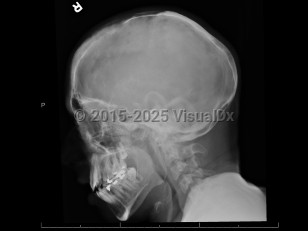Emergency: requires immediate attention
Hypophosphatasia
Alerts and Notices
Important News & Links
Synopsis

Hypophosphatasia (HPP, Rathburn disease) is a rare, possibly life-threatening, genetic metabolic disease defined by low tissue-nonspecific alkaline phosphatase (TNSALP) activity in the serum that disrupts the mineralization process, affecting the proper development of bones and teeth.
Severe forms of HPP are rare and estimated to occur in about 1 of 100 000 newborns. Milder cases that occur in childhood or adulthood occur with more frequency. HPP has been reported in individuals of various ethnicities, but has been reported to occur in a higher frequency in a Mennonite population in Manitoba, Canada.
Clinical signs and symptoms vary widely and may present any time before birth or into adulthood. HPP in infancy is typically more severe and life-threatening. Neonate HPP symptoms include weakening and softening of bones, skeletal abnormalities, poor feeding, failure to thrive, respiratory problems, and hypercalcemia, which may cause vomiting or renal complications. The childhood / adulthood presentation is usually less severe. One of the first presenting signs in children is early loss of baby teeth. Children may also have short stature with bowed legs or knock knees, enlarged wrist and ankle joints, and an abnormally shaped skull. Adults presenting with HPP may have osteomalacia, recurrent foot and thigh bone fractures, and resulting chronic pain. Adult patients may also have premature loss of adult teeth, and joint pain and inflammation. The mildest form of HPP is odontohypophosphatasia, a condition affecting only the teeth and having no impact on the skeletal system; it does not affect life expectancy.
Caused by a mutation of the ALPL gene and typically inherited in an autosomal recessive pattern. Milder types of HPP may be inherited in an autosomal recessive or autosomal dominant pattern.
Treatment is supportive in childhood and adult forms of the disease and may include NSAIDs in children and teriparatide in adults. Dental monitoring is important. Enzyme replacement therapy may be of benefit.
The perinatal form is usually fatal within the first weeks of life. Respiratory complications are common in the infantile form of the disease.
Severe forms of HPP are rare and estimated to occur in about 1 of 100 000 newborns. Milder cases that occur in childhood or adulthood occur with more frequency. HPP has been reported in individuals of various ethnicities, but has been reported to occur in a higher frequency in a Mennonite population in Manitoba, Canada.
Clinical signs and symptoms vary widely and may present any time before birth or into adulthood. HPP in infancy is typically more severe and life-threatening. Neonate HPP symptoms include weakening and softening of bones, skeletal abnormalities, poor feeding, failure to thrive, respiratory problems, and hypercalcemia, which may cause vomiting or renal complications. The childhood / adulthood presentation is usually less severe. One of the first presenting signs in children is early loss of baby teeth. Children may also have short stature with bowed legs or knock knees, enlarged wrist and ankle joints, and an abnormally shaped skull. Adults presenting with HPP may have osteomalacia, recurrent foot and thigh bone fractures, and resulting chronic pain. Adult patients may also have premature loss of adult teeth, and joint pain and inflammation. The mildest form of HPP is odontohypophosphatasia, a condition affecting only the teeth and having no impact on the skeletal system; it does not affect life expectancy.
Caused by a mutation of the ALPL gene and typically inherited in an autosomal recessive pattern. Milder types of HPP may be inherited in an autosomal recessive or autosomal dominant pattern.
Treatment is supportive in childhood and adult forms of the disease and may include NSAIDs in children and teriparatide in adults. Dental monitoring is important. Enzyme replacement therapy may be of benefit.
The perinatal form is usually fatal within the first weeks of life. Respiratory complications are common in the infantile form of the disease.
Codes
ICD10CM:
E83.39 – Other disorders of phosphorus metabolism
SNOMEDCT:
190859005 – Hypophosphatasia
E83.39 – Other disorders of phosphorus metabolism
SNOMEDCT:
190859005 – Hypophosphatasia
Best Tests
Subscription Required
References
Subscription Required
Last Updated:07/15/2018
Emergency: requires immediate attention
Hypophosphatasia

